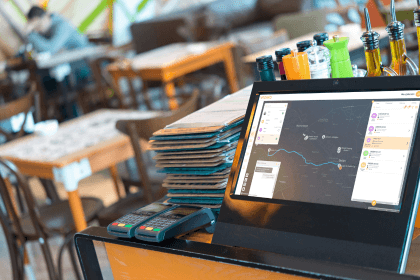
5 ways to succeed with food delivery during your busy season
September 4, 2022
Learn how delivery management software can help restaurants navigate challenges of third-party food delivery and create a profitable win-win!

Without a dedicated delivery management system to help bridge the gap between vastly different tech stacks, the relationship between marketplace apps and restaurant operators can be best described as love-hate – it’s certainly complicated!
On the upside, third-party delivery apps have revolutionized the food delivery industry. They have done so by bringing high-value customer acquisition opportunities and scaling revenue streams to restaurant brands.
On the downside, however, popular marketplace apps are fraught with high delivery charges (anywhere from 15-30% on each order) and offer limited control over the delivery process. This makes it difficult for restaurants to generate profits and build relationships with their customers when it comes to delivery orders.
According to BusinessofApps, Doordash had 25 million active users and 390,000 merchant partners, phenomenal figures posted by the market leader, with a 65% share of US food delivery space as of 2023.
With restaurant delivery growth in double digits, marketplace apps look set to continue to grow their share of a restaurant’s business.
Therefore, logic dictates that restaurant operators intent on tapping into such growth should start optimizing their relationships with food delivery apps instead of avoiding them.
In order to make the relationship more sustainable, operators must find a solution that gives them control over the entire process.
Such a solution should offer discounted delivery service fees, better control over the customer delivery journey, and improved customer service levels.

The restaurant food delivery industry in the US is predicted to reach $231bn by 2023.
If food businesses don’t find a better solution, their dependence on third-party apps will only increase. In addition, their margins will continue to dwindle.
To tackle the high-cost fees and visibility issues associated with third-party delivery companies, many restaurants are turning to restaurant delivery software solutions.
The right software solution can help restaurant brands to drive down their delivery fees with exclusive discounted delivery partner rates, automate their dispatch efforts, and dramatically improve their end-customer experience (even during their busiest seasons).

When it comes to marketplace delivery, the economics fail to stack up.
Paying up to 15% to capture more order volume makes sense for restaurant brands. However, paying an additional 15% for delivery means sacrificing most of the remaining margin to be made.
Luckily, however, delivery management partners can help you to achieve more favorable rates for your third-party food delivery services.
This is the most sustainable solution for restaurants that wish to continue using marketplace fleets without compromising their revenue.
By using a delivery management solution with extensive partnerships, restaurants can save up to 24% on delivery fees while continuing to access new customers, meet current customer expectations, and generate more revenue from the marketplace platform.
Ultimately, turning the delivery business side of their restaurant into a new stream of revenue.
When a delivery driver from a marketplace fleet fulfills an order, the restaurant has no control over the service levels the end customer will receive.
In light of this, having delivered an order to your customer, a marketplace delivery driver could have taken multiple delivery routes to fulfill other orders along the way.
This often results in reduced operational efficiencies, late delivery times, cold food, and negative reviews for operators who are ultimately blind to the issues at hand.
Using a delivery management software solution can offer major benefits through driver tracking.
This can help to provide the restaurant with detailed data and analytics on delivery orders to increase delivery efficiency and give operators full visibility over the entire delivery process (and yes, that does apply to orders fulfilled by third-party fleets too!).
With access to this real-time tracking, restaurants can identify areas for improvement, make data-driven decisions, and optimize their delivery operations accordingly.

The key is to establish a successful relationship where both parties benefit.
In order to achieve this, there needs to be some flexibility within the ecosystem.
As a result, there are two scenarios in which both the restaurant and the marketplace delivery agents can benefit:
The restaurant continues to use its own fleet of drivers with a delivery management system that enables them to overflow excess deliveries, at a reduced rate, to third-party delivery drivers when their own drivers are at full capacity.
This scenario means that a restaurant can fulfill all orders without worrying about expensive fees or poor customer engagement. With this, the marketplace also has the opportunity to capture new order volume and fulfill overflow orders that once may have not been available to them.
The restaurant continues to exclusively use 3rd party delivery fleets for fulfillment but incorporates a system that helps them to manage orders, track performance, and avail of discounted delivery rates.
This alternative scenario structure allows restaurants to continue benefiting from the convenience of marketplace delivery in tandem with driving down their delivery costs. It also ensures the continued need for marketplace apps while offering them the chance to become the priority fleet for that restaurant brand.
Based on the evidence outlined above, it’s safe to conclude that the relationship between marketplace apps and restaurant operators is quite complicated, to say the least. But like most real-world relationships, there are synergies to be gained from nurturing and investing in them.
Both parties depend on one another but in order for the relationship to remain structural, both sides need to be profitable.
For restaurants that are looking to increase profitability, the solution is to list with all marketplace apps but be selective with how you manage the delivery aspect of those orders. The most efficient and profitable way to do this is by using the right delivery management software.
By availing of low-cost delivery, gaining greater visibility over the delivery process, and taking back ownership of customer engagement, restaurants can build a better food delivery strategy that helps them to drive down their costs and make their delivery channel a more profitable one.
If you’re a restaurant operator looking to optimize your relationship with marketplace apps by availing of discounted delivery fees, book a free demo with our team today.
Read more about the restaurant delivery industry below!

September 4, 2022

February 24, 2023

March 30, 2023